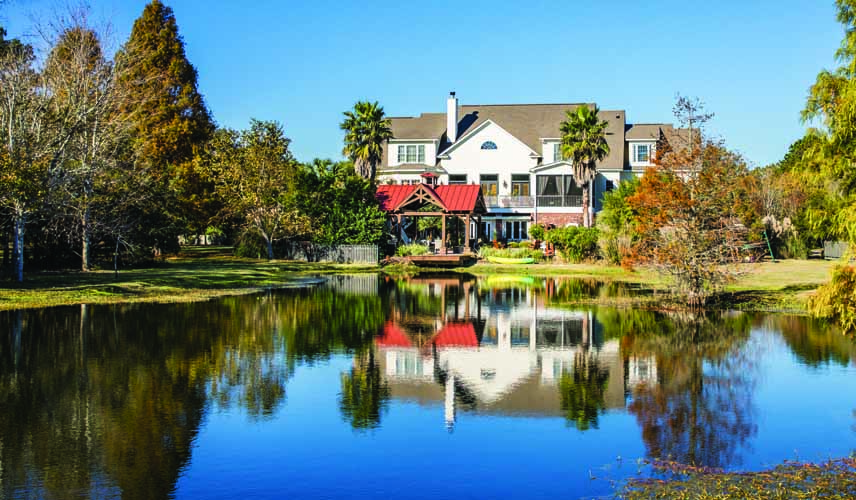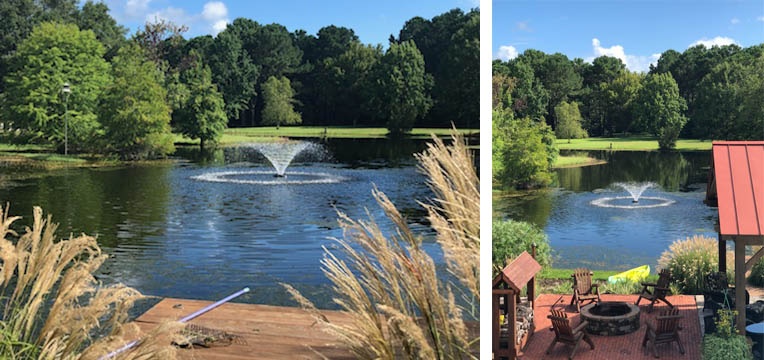
The tag line “water, water everywhere ” is something you frequently see in ads that market the breathtaking landscape of Charleston SC and the surrounding lowcountry. From the vast waters of the Atlantic, to the Intracoastal Waterway, tidal creeks, rivers and marshes, there are many and varied sources for a water lifestyle in Charleston. But with its low sea level elevation and high water table, managing the water that comes from high tides, hurricanes and coastal deluges means that Charleston relies on a good system of fresh water ponds and manmade retention ponds. Municipalities and neighborhoods in and around Charleston see water management as a top priority to alleviate the threat of surface flooding, and oftentimes a series of healthy, well-connected ponds help to quickly dissipate and manage an unexpected influx of water. For that reason neighborhood Homeowner Associations around Charleston cite ongoing pond management as a key part of their maintenance oversight.
In our neighborhood, we have a large, 2-acre fresh water pond that spans the lot lines between three houses but for the most part, falls squarely in our yard. Each summer over the last four years we have seen increasing issues with algae and perimeter weeds eventually resulting in near total blanketing of large areas. So this year it was finally time to tackle this “monster of the lake ” and bring it back to good health.
FIRSTLY, LET’S UNDERSTAND THE PROBLEM
Issues began when we expanded the size of the lake about 30% by digging further into our rear yard. This greatly increased the shallow water areas and, in all probability, added considerably to the nutrient load in the water by exposing it to recently disturbed earth. The pond edges should have been made steeper to limit the growth of nuisance weeds around the edges, but that was hindsight and we are not able to change geometry at this point. In addition to that, each year we experience a glut of long algae filaments growing mainly from the pond bed but often breaking off forming large floating mats. The mats then degraded in the strong summer sunshine turning brown and producing a frothy mass than prevented light from penetrating in to the pond and also further warming up the water depleting its oxygen content. This is a common scenario that tips a seemingly healthy pond into a pond in poor health.
So off we went to Tractor Supply in in nearby Ravenel, SC and bought algae control in the form of aquatically safe copper sulphate. This is diluted and sprayed in to the water. Algae strings are a a long chain of independent cells so it’s necessary to get the treatment into the water column and in part this worked quite well. We also treated the weed with an aquatic herbicide but with less success. Although keeping the worst at bay, we resorted to the physical removal of the weeds two or three times a year. What that really means is our young son and I getting in to the lake and pulling it all out whilst my long suffering bride intermittently shouts, “get out there are snakes in there. ” We also added 20 topoloid (sterile) grass carp to try to eat the weed out of existence. On a 2-acre lake this made no difference at all.

This year we finally admitted defeat as the problem continued to get worse and was threatening to cover the entire lake surface. So we called in the professionals in the form of “The Lake Doctor” and we have been very impressed so far.
HERE’S WHAT THEY DID:
- Hit all the nuisance weed all around the pond edge with aquatically safe defoliant. This knocked all their leaves off, starting the process of starving the plants out of existence. A second application 5-weeks later killed their slow revival and now the stems are breaking up and floating around. It was kind of satisfying to watch, really.
- Applied algaecide to the floating filimentacious rafts and water column. This stopped further growth and began to break up the rafts themselves.
- Applied a substance that resembled fertilizer to the water column, but we were assured is actually a mixture of bacteria that help break down decaying plant matter.
- There is always a fear when cleaning up a water column that you generate so much decaying plant matter it eats up all the oxygen in the lake, kills fish and other critters, then anaerobic decay begins and the lake effectively dies. So to prevent that, the final step toward restoring good health to the pond, we fitted a floating fountain to continually aerate the water. This was left off until the algae began to really break up preventing it from blocking the suction. We’ve also been physically removing the floating rafts of plant matter we can reach to accelerate the cleanup.
The Lake Doctors have returned now twice. They initially said it would be a slow steady process and was inadvisable to really “shock ” anything, which is a common chemical solution for this scenario. The pond is now clear of weed rafts on the edges. The algae is nearly gone from the surface. We can now see fish again and see them jumping for insects. We’ve seen osprey swooping for fish, including one of our now large carp recently added. Snapping turtles swim by lazily looking for their next meal. Their input has made a huge difference, the lake again looks beautiful, we have our view back – plus a fountain to boot!
Prices and values in real estate in Charleston can be greatly affected by water access and water views, and even proximity to a healthy, scenic neighborhood lake adds value to your home.
Interested in Learning More?
Our expert teams - from development, investment, real estate, and property management - have experienced it all and have the insight to help you along the way.
Find Out More